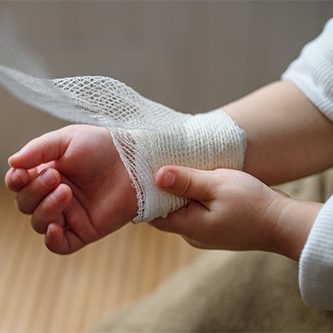What is Wound Care?
Wound care is an essential part of the post-surgery or after any impact. The process of tissue repair is highly complicated and can be unpredictable, because so many factors can influence the process from multiple vectors, for example older patients who might have multiple concurrent illnesses or conditions that influence healing. Every patient's wound care needs are unique to the individual, control and care during the healing process is invaluable to aiding the healing process and avoid challenges.
Generally, the surgical wounds and lacerations made by surgeons as a result of medical or cosmetic surgeries tend to heal without a problem in an otherwise healthy person. Often, the healing period for acute surgical wounds will be anticipated in advance by the treating physician, although this period can be delayed by patient or environmental factors.
Skin
Epidermis, Dermis, Hypodermis, tissue, and numerous other components make up the marvelous layer that covers the human body. In the integumentary system, the skin is considered the largest organ.
Wound
Surely, the skin is the fabulous layer that covers; it gets affected by many external factors and gets wounds, scars, slashes, or many kinds of lacerations. But these wounds heal very quickly with some easy steps and care.

Ways to Bandage a Wound
Every wound is different, because of course, impact, and intensity, here are some ways the wound is closed after applying for suitable anti-bacterial medicine. Stitches: with the help of arc needle and synthetic thread, the wound is closed in sutures, they closely resemble sewing. Some sutures dissolve on their own while some need removing, which after assessment of the wound, can be removed by a specialist. Adhesive: ideally used on small and shallow wounds. Staples: just like metal pins hold the paper together, surgical staples are metal clips that bind skin together until the skin starts healing. These also need to be removed by a specialist and require a unique tool.
Paper Tape: to hold the small wounds together, a non-allergenic tape is used.
Types of wound
It's important to understand that all wounds are not the same, and the reason for the occurrence, and their presentation, impacts significantly on the healing protocol.
Incision
One of the very clean wounds, incisions are the cuts made by sharp objects such as a knife, scissors, a shard of glass, or scalpel, etc. For surgery, when a surgeon cuts open the skin, with the help of a scalpel, this wound is known as incision.
Abrasion
For this wound, the skin may have scratched off on a very rough surface. Sometimes, the skin rubs against the surface with friction. These require some painful healing time, sometimes a tetanus injection, rarely a graft.
Laceration
Because of a forceful impact, the tissue may tear or damage. These wounds are known as lacerations. Depending on how forceful the impact is, the muscle, ligament, nerves, bone, or even organs get lacerations.
Skin Avulsion
Now, this wound has a profound impact and takes a proper course of treatment. In this wound, the skin tears from even the tissue beneath it. Sometimes the skin may be easy to attach; otherwise, a graft comes in order.
Puncture
It is mostly caused by the impact of sharp objects that may penetrate inside the skin. While the entry site may be smaller than the incision, but the wound is more in-depth, atypically.
Care for Wound
Well, the most immediate care for the wound, depending on intensity, is to visit a health care professional who will tend to it with proper protocols. If not tended with the right protocols, the wound may develop infections, and that can add more distress.
Medicine
Firstly, after cleaning the wound, an antiseptic is applied on the wound, to ensure no bacteria or dirt is left behind. If the wound is deeper, like a gash or incision, the antibiotics are also administered orally. Your health care professional will also guide you on how to keep your wound clean and dry for a few days.
Emollient
Depending on the impact, medicine or Medicated Emollient is applied on the wound before putting up the dressing, while closing the wound. Moreover, for smoother healing, to avoid infections, and less or no scarring, emollient or medication are prescribed for later use as well.
Clothes
Some wounds need extra care, can have allergic reactions to certain kinds of fabrics; hence, doctors prescribed clothes. Mostly, loose clothing, preferably airy like cotton. No hard clothing like collars, cuffs, or elastic.
Continued Care
Ideally, the wound should gradually hurt less and look closer to the skin every day. It's best to keep dressing wounds with medication and emollients prescribed by the doctor. If, in any way, the wound looks red and hurts more than usual, consult the doctor immediately.
Post-Surgery care
In particular, the surgeons will guide you in great detail on how to care for the wound. These are some interpretive signs to watch out for some weeks post-surgery:
- Inflammation
- Bleeding
- Pus
- Swelling
- Pain
- Boils
- Necrosis
Medical conditions such as Diabetes, Anemia, Vascular Disease Varicose veins Ulcers etc.
Surgical Wounds
Firstly, these wounds are very carefully planned and executed by a specialized surgeon for a procedure. Mostly, each wound is unique, depending on the procedure, nature of the surgery, person's case, weight, and height.
All things considered, these factors accumulate to the size and depth of the wound, but since these wounds are calculated, they are mostly a clean cut. With this is in mind, these wounds have very clean margins and heal with care effortlessly.
To enumerate, the surgical wounds are mainly classified into four categories for better understanding and after surgery care.
Category 1: These wounds are very clean, and need less care post-surgery, with less or no scarring and minimum inflammation.
Category 2: Also known as clean-contaminated, although it may have no infection, but has high chances of developing one.
Category 3: These wounds have come in contact with a foreign object, for example, a gunshot wound. They have categorized as well as infected wounds and contaminated.
Category 4: just like the name suggests, these wounds are extremely contaminated with fecal matter mostly.


